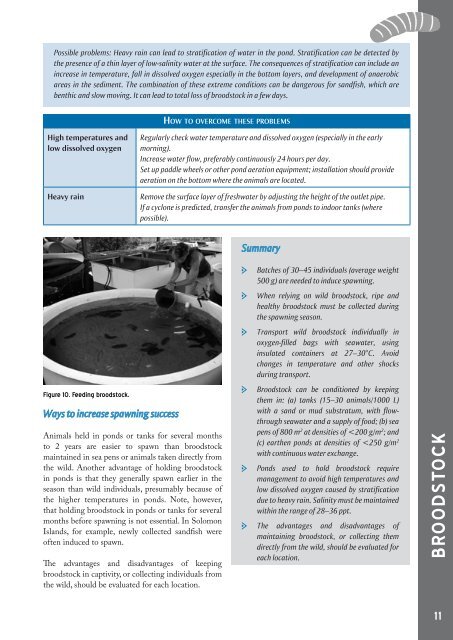Sandfish hatchery techniques - English version - ACIAR
Sandfish hatchery techniques - English version - ACIAR
Sandfish hatchery techniques - English version - ACIAR
You also want an ePaper? Increase the reach of your titles
YUMPU automatically turns print PDFs into web optimized ePapers that Google loves.
Possible problems: Heavy rain can lead to stratification of water in the pond. Stratification can be detected by<br />
the presence of a thin layer of low-salinity water at the surface. The consequences of stratification can include an<br />
increase in temperature, fall in dissolved oxygen especially in the bottom layers, and development of anaerobic<br />
areas in the sediment. The combination of these extreme conditions can be dangerous for sandfish, which are<br />
benthic and slow moving. It can lead to total loss of broodstock in a few days.<br />
High temperatures and<br />
low dissolved oxygen<br />
How to overcome tHese problems<br />
Regularly check water temperature and dissolved oxygen (especially in the early<br />
morning).<br />
Increase water flow, preferably continuously 24 hours per day.<br />
Set up paddle wheels or other pond aeration equipment; installation should provide<br />
aeration on the bottom where the animals are located.<br />
Heavy rain Remove the surface layer of freshwater by adjusting the height of the outlet pipe.<br />
If a cyclone is predicted, transfer the animals from ponds to indoor tanks (where<br />
possible).<br />
Figure 10. Feeding broodstock.<br />
Ways to increase spawning success<br />
Animals held in ponds or tanks for several months<br />
to 2 years are easier to spawn than broodstock<br />
maintained in sea pens or animals taken directly from<br />
the wild. Another advantage of holding broodstock<br />
in ponds is that they generally spawn earlier in the<br />
season than wild individuals, presumably because of<br />
the higher temperatures in ponds. Note, however,<br />
that holding broodstock in ponds or tanks for several<br />
months before spawning is not essential. In Solomon<br />
Islands, for example, newly collected sandfish were<br />
often induced to spawn.<br />
The advantages and disadvantages of keeping<br />
broodstock in captivity, or collecting individuals from<br />
the wild, should be evaluated for each location.<br />
Summary<br />
h<br />
h<br />
h<br />
h<br />
h<br />
h<br />
Batches of 30–45 individuals (average weight<br />
500 g) are needed to induce spawning.<br />
When relying on wild broodstock, ripe and<br />
healthy broodstock must be collected during<br />
the spawning season.<br />
Transport wild broodstock individually in<br />
oxygen-filled bags with seawater, using<br />
insulated containers at 27–30°C. Avoid<br />
changes in temperature and other shocks<br />
during transport.<br />
Broodstock can be conditioned by keeping<br />
them in: (a) tanks (15–30 animals/1000 L)<br />
with a sand or mud substratum, with flowthrough<br />
seawater and a supply of food; (b) sea<br />
pens of 800 m 2 at densities of
















